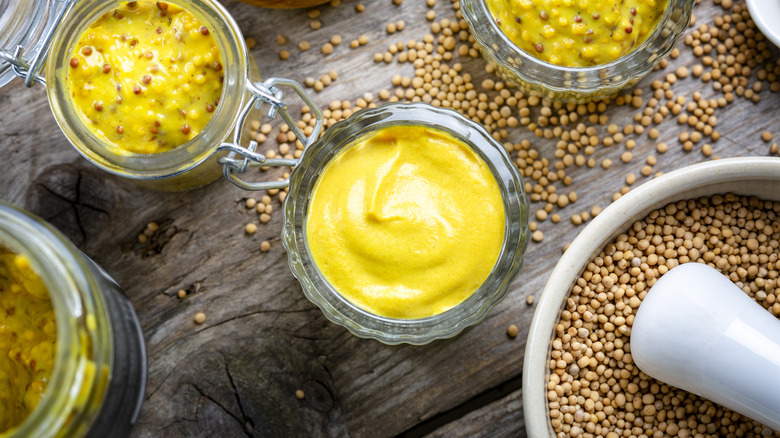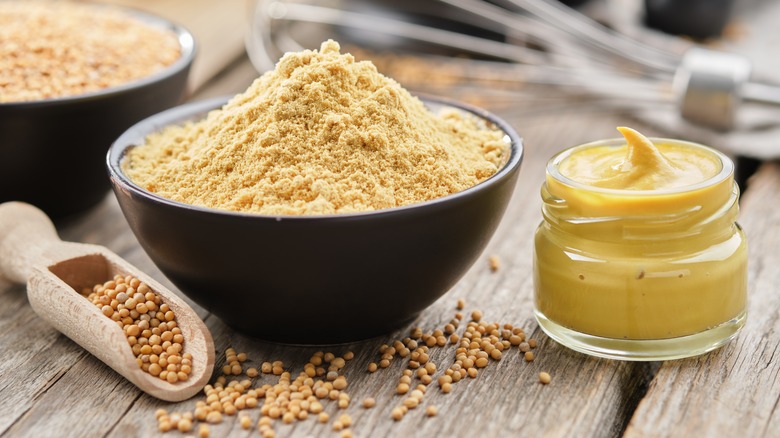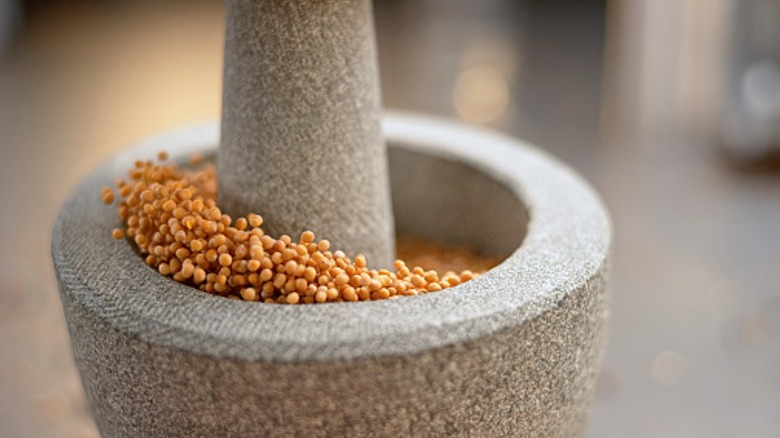Why It Always Pays To Make Your Own Mustard At Home
Condiment connoisseurs know that there are a number of mustard varieties that you should be familiar with, and if you like dishes with a spicy kick, there's almost bound to be a mustard for every occasion — or at least for many of them. From using spicy brown mustard to jazz up potato salads to Dijon on your favorite sandwich and any one of a number of German mustards for seriously improving on sausages and pretzels, there are plenty of reasons to keep multiple mustards on hand.
Now, we're going to give you a reason to have different varieties of mustard seeds in your pantry, and that's the simple fact that the less time that elapses between grinding mustard seeds and smearing it on your food, the more pungent and aromatic that mustard will be. That's true whether you're making yellow mustard for hot dog night or if you're whipping up a mustard dressing for a salad.
Mustard has been around for a long time. It was used as an ingredient in China at least 2,500 years ago, was familiar to ancient Egyptians and Sumerians, the ancient Greeks considered it medicinal, and it was the ancient Romans who first turned it into a condiment. That means we've had a lot of time to experiment with mustard and discover what it takes to make a truly delicious spread, and the good news is that it's knowledge that's easy to incorporate into your own cooking.
There's a little science that goes into creating the best mustards
All you really need to make mustard is your mustard seeds of choice and a liquid. It's that easy. But the variety of options out there can make this one seem a little complicated. It's not, and we will give you some guidelines that are easy to remember.
Colman's Mustard is a brilliant example of how liquids matter in terms of preservation and flavor. This notoriously spicy mustard is traditionally mixed only with cold water, but slather this on a hot dog as you would do with American yellow mustard, and your sinuses will never forgive you. That's actually a characteristic of mustards made with water. They're going to be spicier initially but won't keep their heat as long as vinegar-based mustards, and that's because water reacts instantly with the compounds in mustard, while acids slow that chemical reaction down.
And that can help you decide what liquid to use. Since the addition of acids like vinegar and ingredients like horseradish help preserve that bite and flavor, don't worry too much about adding anything acidic if you're just making enough to use with dinner. If you're making up some to keep in the fridge for a few days, though, opt for something acidic. That can make a huge difference: With some varieties, it only takes a matter of hours for mustard to get, well, not-so-mustardy. Keep that in mind, and you'll be able to plan accordingly.
There are some wildly creative ways you can make homemade mustard
Grinding mustard seeds is easy, and there are a few tools that will get the job done. A coffee grinder or spice grinder will work just fine, but if you'd like to go old school, get a mortar and pestle. Not only is it easier to clean, but you'll be able to imagine you're an old-timey alchemist while you're grinding your seeds because alchemy is kind of exactly what you're doing.
Making mustard is a mix-and-match sort of thing. After grinding your seeds, you'll need a liquid. Different kinds of vinegar will, of course, give you different flavors, but you can also opt for using beer, wine (although you'll probably want to stick with white), and ciders, which are all perfectly legitimate possibilities. Then, you can add other spices and seasonings. Try fresh herbs, a drizzle of honey or maple syrup, a dash of salt, and you should definitely get creative. Think that a curry mustard dressing sounds like it would be delicious on a salad or wrap? It is!
We mentioned before that one of the earliest examples of mustard as a condiment comes from ancient Rome, and that recipe was actually preserved in the writings of Apicius. If you're up for trying it, choose brown or black mustard seeds, cold water, and red wine vinegar for your liquid, then add chopped almonds and pine nuts and a dash of salt. Enjoy!


